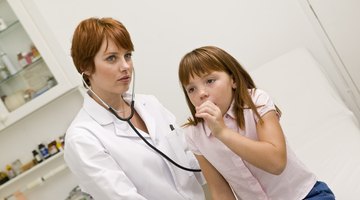How Long Does Hand, Foot & Mouth Last?
Tips for Surviving a Bout of Hand, Foot and Mouth Disease
Your little germ magnet seems to pick up all sorts of new and interesting viruses. Hand, foot and mouth disease is one of many contagious viral infections your little one can pick up at day care. The name sounds strange, but the virus is generally a mild and relatively brief, albeit uncomfortable, illness that's common with kids.
What Is Hand, Foot and Mouth Disease?

Redness on the Face in Children
Learn More
It sounds like something a veterinarian deals with, but this viral infection is a very real issue that many parents have to handle. Hand, foot and mouth disease is a contagious viral illness that causes sores inside the mouth. On the outside of the body, you may notice a rash that looks like flat, red spots primarily on the palms of the hands and soles of the feet. The rash sometimes extends to the buttocks, genital area, elbows, knees and legs. Some kids have blisters on those areas.
Other symptoms of the illness include:
- Fever
- Sore throat
- Decreased appetite
- General unwell feeling
- Irritability
- Pain with the sores
Symptoms aren't necessarily the same case to case. Some people don't even notice the symptoms. Your child may have all the symptoms or only a few.
How Long Does It Last?
The window between infection and the first symptoms appearing is usually three to six days. Fever and a sore throat are common first signs of the infection. The painful mouth sores usually pop up a day or two after the fever starts. Rashes on other body parts may start a day or two after that.
Hand, foot and mouth disease typically runs its course in seven to 10 days. People infected with the virus are most contagious for the first seven days, but it's important to note that the virus can hang around in your body even after the symptoms go away. It's possible to infect someone else days or weeks after symptoms disappear because of the lingering virus. Some infected people never have any symptoms, but are still contagious.
Who Gets Hand, Foot and Mouth Disease?

My Toddler Has Red Palms & Soles of the Feet
Learn More
Those most often found with the virus that causes hand, foot and mouth disease are kids 5 years of age and under, but it's common up to age 10. It's also possible for older kids and adults to get it.
The virus spreads through nasal secretions, throat discharge, blister fluid, stools and airborne droplets from coughs or sneezes. Young kids come into contact with the germs at day care or when playing with friends. Since their hands often go directly into their mouths, younger kids are often exposed to the virus very easily.
Treatment Options
Hand, foot and mouth disease has no treatment option to shorten the illness because it's viral. However, you can help your child feel better and maybe put a smile back on his face. Ibuprofen or acetaminophen dosed properly for your child's age helps relieve the pain. If your child's rash feels itchy, use calamine or similar anti-itch creams. Cool, soothing foods like yogurt and ice pops can relieve sore throat pain. Encourage your little patient to drink lots of fluids to avoid dehydration.
When to See a Doctor
Your pediatrician can't prescribe medication to cure the illness, but it's still a good idea to schedule an appointment if you suspect your child has hand, foot and mouth disease. Your doctor can confirm the diagnosis and rule out other causes.
The illness is usually minor, but complications can arise, so watch for worsening or unusual symptoms. Dehydration is common in kids who don't want to drink due to the pain and difficulty of swallowing that sometimes accompanies the mouth sores.
Coxsackievirus, one of the viruses that is usually responsible for the illness, can cause severe problems in the brain in very rare cases, including viral meningitis and encephalitis. Both conditions are very rare, but keeping a close eye on your child's condition is important.











